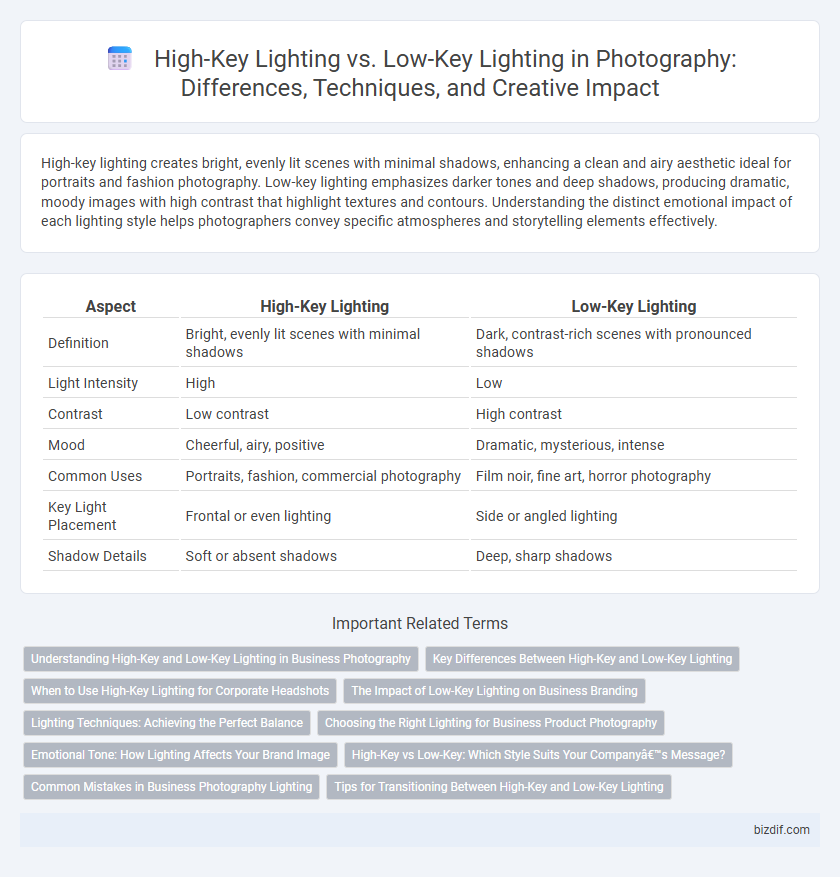High-key lighting creates bright, evenly lit scenes with minimal shadows, enhancing a clean and airy aesthetic ideal for portraits and fashion photography. Low-key lighting emphasizes darker tones and deep shadows, producing dramatic, moody images with high contrast that highlight textures and contours. Understanding the distinct emotional impact of each lighting style helps photographers convey specific atmospheres and storytelling elements effectively.
Table of Comparison
| Aspect | High-Key Lighting | Low-Key Lighting |
|---|---|---|
| Definition | Bright, evenly lit scenes with minimal shadows | Dark, contrast-rich scenes with pronounced shadows |
| Light Intensity | High | Low |
| Contrast | Low contrast | High contrast |
| Mood | Cheerful, airy, positive | Dramatic, mysterious, intense |
| Common Uses | Portraits, fashion, commercial photography | Film noir, fine art, horror photography |
| Key Light Placement | Frontal or even lighting | Side or angled lighting |
| Shadow Details | Soft or absent shadows | Deep, sharp shadows |
Understanding High-Key and Low-Key Lighting in Business Photography
High-key lighting in business photography emphasizes bright, evenly lit scenes that convey professionalism, cleanliness, and approachability, ideal for corporate portraits and product shots. Low-key lighting creates strong contrasts with deep shadows, enhancing mood, depth, and drama, making it suitable for luxury brands or highlighting textures and details. Mastering these lighting techniques enhances brand storytelling by aligning visual tone with business identity and target audience expectations.
Key Differences Between High-Key and Low-Key Lighting
High-key lighting emphasizes brightness and minimizes shadows to create a soft, evenly lit image ideal for portraits and commercial photography, using multiple light sources and reflectors. Low-key lighting, in contrast, uses strong contrasts and deep shadows to produce dramatic, moody visuals, relying on a single key light and minimal fill light. These lighting styles differ significantly in their use of contrast, shadow detail, and emotional tone, affecting the overall mood and perception of the photograph.
When to Use High-Key Lighting for Corporate Headshots
High-key lighting is ideal for corporate headshots when aiming to convey approachability, professionalism, and clarity, as it minimizes shadows and produces a bright, evenly lit image that highlights facial features without harsh contrasts. This lighting style suits industries such as technology, finance, and healthcare, where a clean and inviting visual presentation supports brand identity and fosters trust. Using high-key lighting in controlled studio environments ensures consistent results, making it effective for company websites, marketing materials, and LinkedIn profiles.
The Impact of Low-Key Lighting on Business Branding
Low-key lighting creates dramatic shadows and contrasts, enhancing brand identity with a sense of mystery and sophistication. This technique emphasizes textures and shapes, helping businesses convey luxury, elegance, or exclusivity in advertising campaigns. Using low-key lighting strategically can boost audience engagement by evoking emotional responses and reinforcing brand differentiation in competitive markets.
Lighting Techniques: Achieving the Perfect Balance
High-key lighting emphasizes bright, evenly distributed light to minimize shadows and create a clean, airy aesthetic, often used in fashion and portrait photography for a soft and cheerful mood. Low-key lighting utilizes strong contrasts and deep shadows to evoke drama, mystery, or intensity, commonly employed in artistic and cinematic photography. Mastering the balance between high-key and low-key lighting techniques allows photographers to control emotional tone and visual impact with precision.
Choosing the Right Lighting for Business Product Photography
High-key lighting uses bright, even illumination to minimize shadows, creating clean and vibrant images that highlight product details and convey a fresh, modern aesthetic ideal for beauty, tech, and fashion products. Low-key lighting emphasizes shadows and contrast, producing dramatic, moody visuals that enhance texture and depth, making it perfect for luxury goods, artisanal items, and products with rich details. Selecting the right lighting style depends on the brand identity and target audience, ensuring the product's features are showcased effectively to drive customer engagement and sales.
Emotional Tone: How Lighting Affects Your Brand Image
High-key lighting creates a bright, airy atmosphere that evokes positivity, openness, and friendliness, making it ideal for brands aiming to appear approachable and energetic. In contrast, low-key lighting uses deep shadows and strong contrasts to convey mystery, sophistication, and intensity, aligning with brands seeking a dramatic or luxurious image. Understanding these emotional tones allows photographers to strategically influence audience perception and reinforce brand identity through lighting choices.
High-Key vs Low-Key: Which Style Suits Your Company’s Message?
High-key lighting features bright, even illumination that minimizes shadows, creating an upbeat and clean aesthetic ideal for brands promoting positivity, transparency, and energy. Low-key lighting uses strong contrasts and deep shadows to evoke drama, mystery, or sophistication, making it suitable for companies seeking a bold, luxurious, or intense image. Choosing between high-key and low-key depends on your company's message: vibrant, approachable brands benefit from high-key's clarity, while brands emphasizing elegance or intrigue thrive with low-key's moodier tones.
Common Mistakes in Business Photography Lighting
Common mistakes in business photography lighting often involve improper use of high-key and low-key setups, such as insufficient contrast in high-key lighting that leads to flat, lifeless images or excessive shadows in low-key lighting that obscure facial features and details. Failing to balance light intensity and direction results in unflattering highlights and deep shadows, reducing the professional appeal of corporate portraits. Correct application of high-key lighting requires evenly distributed soft light to emphasize clarity, while low-key lighting demands precise control to maintain mood without sacrificing image detail.
Tips for Transitioning Between High-Key and Low-Key Lighting
To transition effectively between high-key and low-key lighting in photography, adjust the light intensity and contrast by increasing or decreasing the number of light sources and their distance from the subject. Use diffusers or softboxes to achieve soft, even lighting for high-key setups, and employ grids or barn doors to create focused, dramatic shadows in low-key photography. Experiment with camera settings like ISO, shutter speed, and aperture to balance exposure and highlight key details in both lighting styles.
High-key lighting vs Low-key lighting Infographic

 bizdif.com
bizdif.com